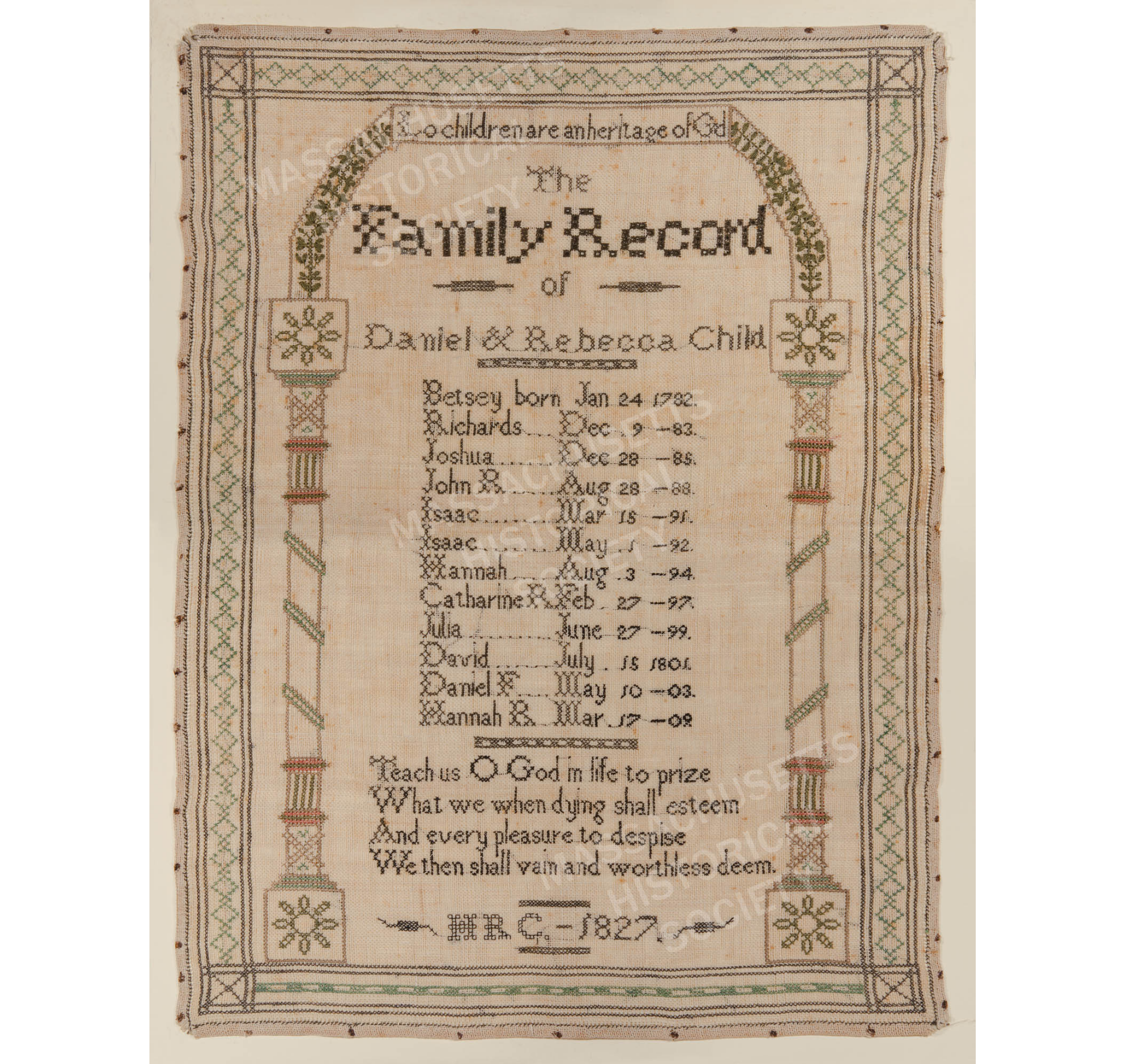Pictorial Silk Embroidery
United States, circa 1820
Pictorial Silk Embroidery
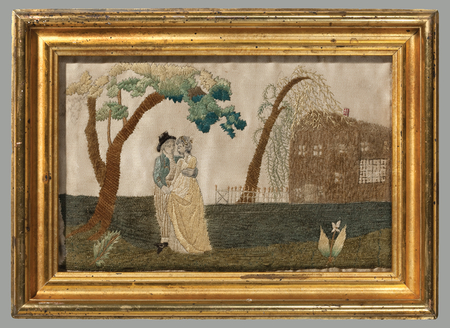
A delightful little silk embroidered picture, this is a depiction of a young couple, perhaps courting, under a tree with a large house in the background. Silk thread was used to depict the young man and young lady, the large leaves, the willow branches, the delicate fence, the brick chimney and the single flowering plant. Beautifully worked chenille threads form the lush lawn, tree trunks and house – overall this is an excellent example. The origin is likely New England, specifically Massachusetts.
The gentleman’s short jacket, striped trousers and hat were fashionable attire in the early 19th century; we particularly like his buckle shoes. The tree in the foreground arches over the couple nicely and its large serrated leaves provide a nice visual component. The two leaves at far left were drawn onto the silk but not stitched, allowing us to know something of the process in this case.
Worked in silk and chenille on silk with graphite pencil drawing, it remains in excellent condition and is conservation mounted into a period gold leaf frame.
Alphabet and Motif Sampler
initialed I.R.,
Scotland, 1793
Alphabet and Motif Sampler
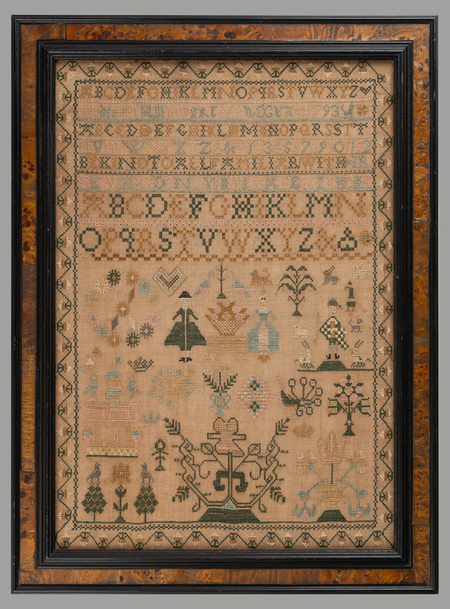
Scottish samplers can include excellent assortments of pictorial motifs as is evident on this praiseworthy example. The samplermaker, who identified herself with her initials at the end of the fifth row from the top, must have enjoyed creating the many depictions – people, peacocks, flowers, trees, birds, rabbits, hearts, stars, and an architectural device known as Solomon’s Porch. The date, 1793, appears near the end of the second row.
A wonderful aphorism was carefully stitched on the fifth and six rows, “Be kind to all familiar with few and only intimate with one.” This was published in Collection of English Prose and Verse For the Use of Schools, Selected From Different Authors by Alexander Barrie, Teacher of English, Writer’s Court, Edinburgh, 1796. It was likely published prior to that as well.
The large uppercase alphabet and narrow bands below it were carefully executed in the eyelet stitch.
The sampler was worked in silk on linen and is in excellent condition. It has been conservation mounted and is in a burl wood frame.
"Worked by an Orphan"
Roman Catholic Orphan Asylum
probably New York, circa 1850
"Worked by an Orphan"
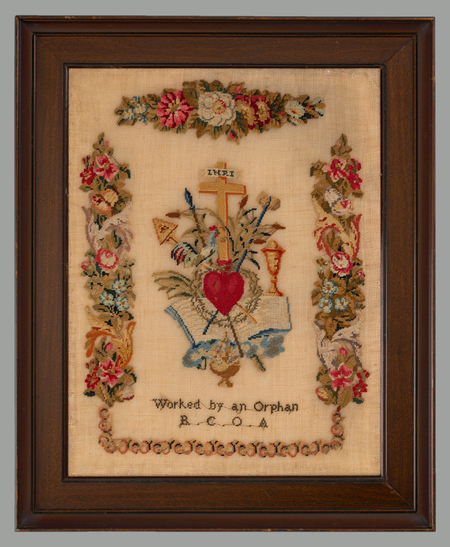
This interesting little sampler is inscribed, "Worked by an Orphan R.C.O.A." and was made at one of the Roman Catholic Orphan Asylums, circa 1850. The first American orphanage was established in New Orleans in 1727 and by the middle of the 19th century the majority of these institutions were run by the Catholic Church, and many were in New York City. Young girls at the orphanages were taught to be exceptional needleworkers and their samplers were considered an indication of their ability.
The central composition is a composition of images with significance to Catholicism, including the cross, chalice, heart, and initials INRI ("Iesus Nazerenus Rex Iudeorum" meaning "Jesus of Nazareth King of the Jews"). The top and side borders are formed of clusters of flowers tightly worked in small-scale Berlin patterns.
Worked in silk on fine linen, the sampler is in excellent condition and has been conservation mounted into a cherry frame.
Amelia Powell
England, 1829
Amelia Powell
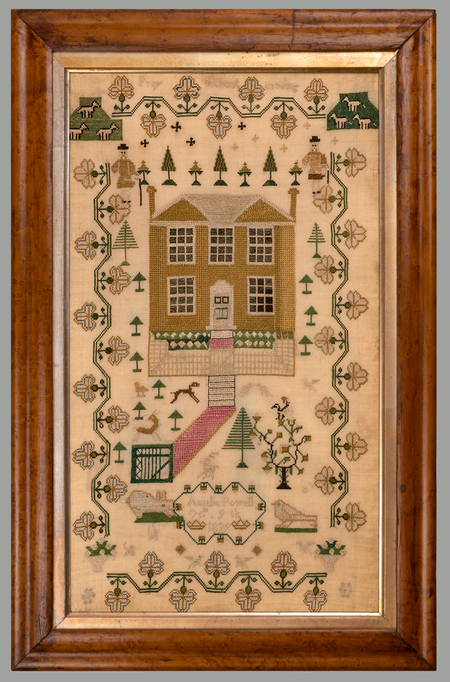
We find this English sampler, with its many excellent pictorial elements, to be very appealing. Central to the composition is a wonderful house with its deep pink diagonal path providing perspective. Details such as the gate that leads to the pink path, the diamond decorated masonry and the paneled front door provide further interest. The two little flocks of sheep add to the graphic interest in the upper corners and two gentlemen with canes (or are these shepherds tending to the sheep?) are tucked into the nearby lineup of pine trees.
The sampler is signed and dated, “Amelia Powell Oct 9th 1829,” inside a cartouche with delightful animals nearby – a fat rabbit and bird, many little birds, deer and a very skinny animal that’s hard to identify. Stitched along the top, outside of the border, is the advice, “Pray without ceasing,” which we have seen on other English samplers.
The sampler was worked in silk on wool and is in excellent condition. It has been conservation mounted and is in its original birds-eye maple frame with a gilt liner.
“Pot Holder”, initialed N. D.
American, 18th century
“Pot Holder”, initialed N. D.
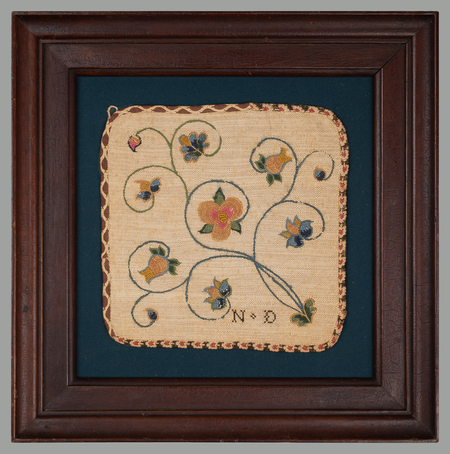
Colonial Americans embraced the drinking and serving of tea and coffee in a social setting throughout the middle of the 18th century, and many accessories related to this custom became equally popular. Needleworkers fashioned decorative pot holders which would appear on the tea table along with silver teapots and ceramic salt glazed sugar bowls. Susan B. Swan in Plain and Fancy: American Women and Needlework, 1650-1850 (Winterthur Museum, 1977), discusses this form and illustrates two examples of pot holders in figures 59 and 85. Swan states that these decorated pot holders are very thin and were probably meant for show rather than protection.
We are pleased to offer this fine and beautifully made example of this very rare form. It is initialed N.D. and was worked circa 1770. This pot holder is illustrated in a book published in 1940 and again in 1963 by Crown Publishing, Inc., entitled, Homespun and Blue: A Study of American Crewel Embroidery by Martha Genung Stearns, as figure 23. The book accompanies the pot holder.
The crewel wool embroidery was gracefully designed and executed and it retains its original binding, a printed fabric of the period. The reverse is plain linen (see photo taken prior to mounting). It is in excellent condition and has been conservation mounted into a late 19th century frame.
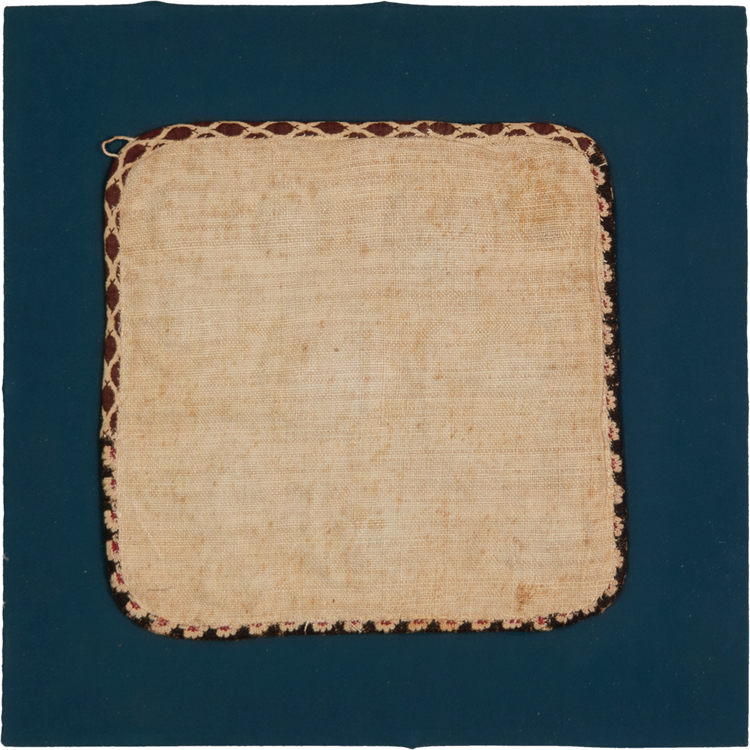
photo of reverse
Silk Embroidery of a Parrot
American, circa 1835
Silk Embroidery of a Parrot
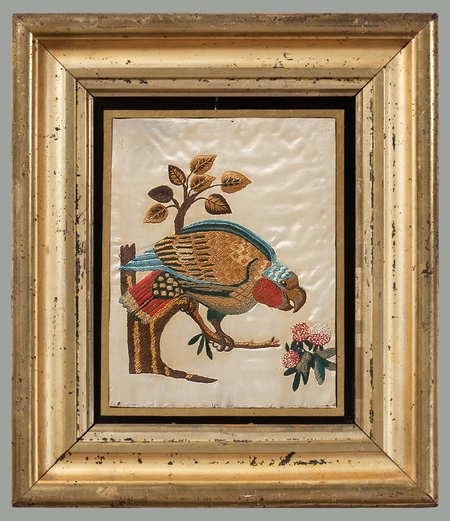
Needleworkers turned their interests to exotic birds in natural settings as they became familiar with and enjoyed the art of John James Audubon, who published The Birds of America between 1827 and 1838. Included were many inspiring color plates, and young ladies produced excellent needlework pictures of similar subjects. This highly colored parrot perched on a branch leaning in towards three fat strawberries is an excellent example - every feather is separated stitched, each leaf is specifically veined and the berries have seeds worked in French knots.
This silk embroidery was worked in silk on silk and remains in its original gold leaf frame and eglomisé mat. It is in excellent condition.
Elizabeth Patrick
Lincoln, Lincolnshire,
England, 1786
Elizabeth Patrick
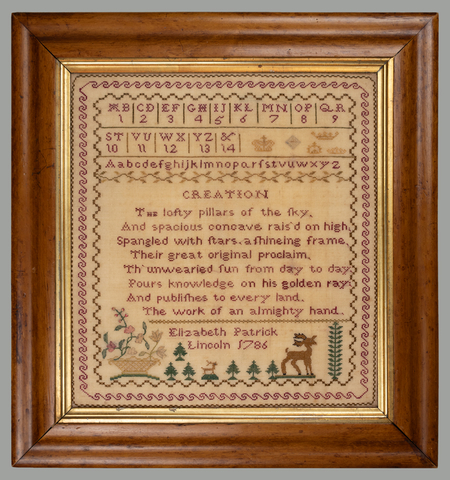
Signed, “Eizabeth Patrick / Lincoln 1786,” this is a beautifully worked, 18th century sampler. The arrangement of the uppercase alphabet at the top, nicely segmented with numerals, is one used by other English samplermakers in the 18th century. The central verse, entitled, “Creation,” was written as Psalm 24 by Joseph Addison.
A delightful little scene of a flower basket, pine trees and two deer provides embellishment nearby her inscription. The larger deer was worked in tiny tent stitches and the little flower petals were completed using an unusual pattern darning stitch.
Elizabeth was christened on April 22, 1776, at St. Benedict Church in Lincoln. Her parents, Matthew and Hannah (Parley) Patrick, were married at the same church in 1772.
The sampler was worked in silk on linen and is in excellent condition. It has been conservation mounted and is in its original maple frame with a gilt liner.
Mary Napper
Harlequin & Columbine,
England, 1814
Mary Napper
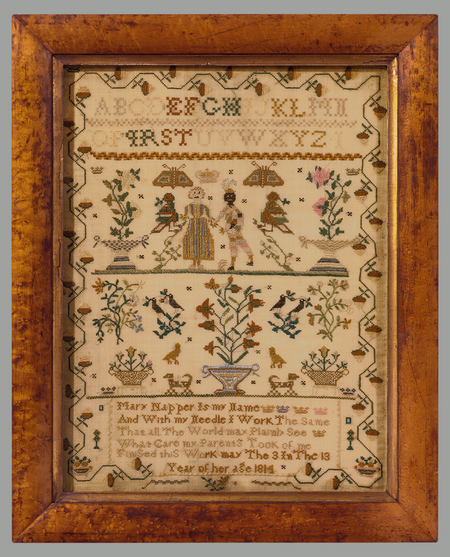
We know of only a very few samplers that include depictions of Harlequin and Columbine. The origin of this couple is with the Commedia del Arte, Italian dramatic performance art of the mid 16th century which featured irreverent street theater. The companies portrayed exuberant characters whose popularity remained intact for centuries and the stories were performed as English pantomimes in the 18th and 19th centuries. Harlequin, a trickster and acrobat, was famous for his parti-colored costume, fanciful hats, and his romantic counterpart was Columbine, a servant in the same household.
Mary Napper’s sampler is a classic and excellent English sampler, with a layered and balanced composition, a very good variety of colors and carefully executed needlework. Her inscription reads, “Mary Napper Is my Name / And With my Needle I Work The Same / That all The World may Plainly See / What Care my Parents Took Of me,” and she stated that she finished it on May 3, 1814. Mary paid particular attention to her portrayal of Harlequin and Columbine, imbuing their faces with strong expression and their colorful costume with good detail; even the splayed fingers of their hands increase their dramatic stance.
Other decorative elements include the large pair of butterflies, many pots of flowers, pairs of parrots and other birds and two whimsical dogs.
Worked in silk on wool, the sampler is in excellent condition. It has been conservation mounted and is in its fine, original maple frame with a gilt liner.
Miniature Sampler
American or English, circa 1825
Miniature Sampler
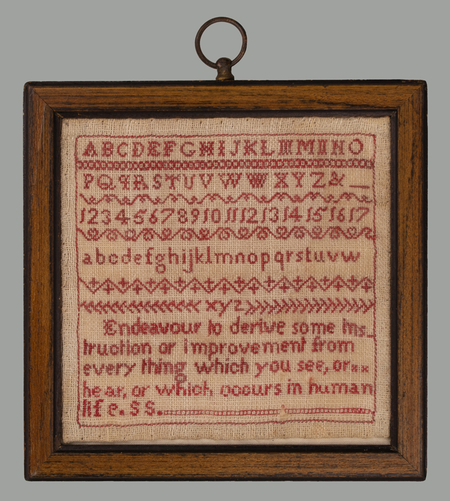
A fine miniature sampler with the most excellent advice, this reads, “Endeavour to derive some Instruction or Improvement from every thing which you see, or hear, or which occurs in human life.” This was written by Ellin Devis (1746 – 1820), an English schoolmistress and author of The Accidence or First Rudiments of English Grammar Designed for the use of Young Ladies, first published in London in 1775, with many subsequent editions. This is thought to have been the first English grammar book written specifically for female students.
The initials SS at the end are likely those of the samplermaker. While we can’t be certain where the sampler was made, the linen ground fabric suggests an American origin.
Worked in silk on linen, the sampler is in excellent condition. It has been conservation mounted into a later 19th century frame.



